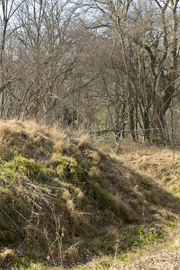Bronze Age 2500 - 700 BC

In The Early Bronze Age 2500BC to 1500BC is split into 4 distinct periods of in Wessex associated with changes in pottery style burial practice and burial style. People are increasingly buried under round barrows with grave goods including metal objects sych as daggers. From 1700 BC the rich inhumation burials evolve into cremation dominated burials.
Cultivation appears to be carried out on a large scale in the Early Bronze Age after which notable volumes of colluvium began to accumulate in dry valleys. This becomes a more widespread change around 2000 BC with subsistence becoming increasingly based on cereal cultivation. Open country species come to dominate the environmental evidence. Ploughing appears for the first time as an agent of landscape change and often proceeds the establishment of settlement and field boundaries.
The Middle Bronze Age 1500-1000 BC sees the creation of a domesticated landscape. Substantial round houses appear and the wider landscape was defined and bounded by field systems. Burials were sometimes placed in barrow cemeteries or flat cemeteries or else contracted inhumations were placed in the ditches of older Round Barrows as at Down Farm. Cremation becomes more common. Towards the end of the second millennium BC a timber circle and avenue was constructed at Ogden Down.
The pattern of settlement in the AONB is mixed with a range of settlement types present. There are both enclosed and unenclosed forms of settlement, with multiple round houses or single dwellings.
The archaeological evidence from the Late Bronze Age 1000 - 700 BC, is much less well known and is defined primarily in relation to metalwork, with an increase in the number of hoards. Some evidence for settlement has been uncovered and there is some evidence for the reorganisation of the landscape with "Wessex linear ditches" cutting across Middle Bronze Age fields.
Environmental Evidence - There is a lack of pollen evidence and our knowledge of the environment of the Bronze Age is derived from soil and mollusc studies. This suggests that the chalk downland was cleared of secondary woodland by the Middle Bronze Age and large scale mixed farmland established on the downland, there seems to be an increase in arable crops through until the Middle Iron Age.
This document forms part of the wider AONB Historic Environment Action Plans.
